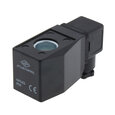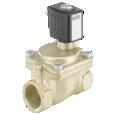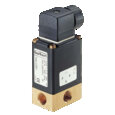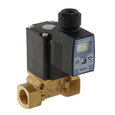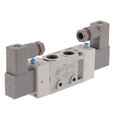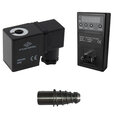AC or DC solenoid valve coil overview
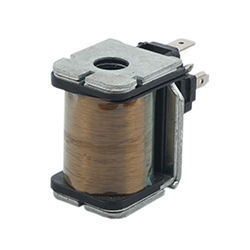
Figure 1: Solenoid valve coil
Solenoids are categorized into two main types: AC solenoids and DC solenoids. AC solenoids operate using alternating current (AC), which periodically reverses direction, while DC solenoids are powered by direct current (DC), which flows in a single, constant direction. Understanding how AC and DC solenoid valves operate is crucial for deciding what type of solenoid is needed for an application. This article explores the differences between these two types of solenoids. It examines the design considerations that should be considered when selecting AC or DC solenoid coils for a specific application.
Table of contents
- When to choose AC or DC solenoid valve
- Working principle
- Performance differences between AC and DC solenoid valves
- Design improvements for AC and DC solenoids
- Using AC solenoids with DC and vice versa
- FAQs
View our online selection of AC and DC solenoid valve coils!

When to choose AC or DC solenoid valve
Consider AC solenoid valves if:
- Rapid actuation is essential, such as in manufacturing and automated production lines
- Energy efficiency is a priority
- An AC power supply is available
Consider DC solenoid valves If:
- Quiet operation is essential, like medical facilities or laboratories
- A steady force is required
- A DC power supply, or batteries are available
For residential fluid control systems, such as garden irrigation, water filtration, or small water features, an AC solenoid valve is typically more suitable for standard household wiring. For projects that use alternative power sources, like battery-operated or solar-powered systems, a DC solenoid valve might be more appropriate due to its compatibility with low voltage power.
Working principle
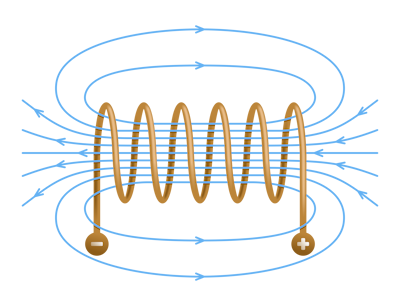
Figure 2: When current passes through a solenoid, it generates a magnetic field (shown with field lines). If wound around a ferromagnetic core, it becomes an electromagnet with enhanced magnetic properties.
DC solenoid valve
DC solenoid valves operate straightforwardly. The coil generates a magnetic force when energized. This force pulls the armature, thereby opening the valve port. Once the power supply is cut off, the coil gets de-energized, and a spring pushes the armature back; this closes the valve. The constant current in DC solenoid valves provides a continuous magnetic pull, resulting in quiet and steady operation without vibrations.
AC solenoid valve
AC solenoids function differently due to the alternating nature of AC, which changes polarity several times per second, creating a sinusoidal wave (Figure 3). This means the coil is continuously energized and de-energized, causing the magnetization to switch on and off. During the off phase, the spring pushes the plunger out, leading to intense vibrations that can stress and overheat the coil, potentially causing it to burn out. Read our solenoid design article for more information on the design, working, and applications of solenoid coils.
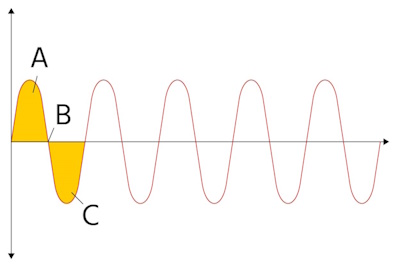
Figure 3: Alternating current nature: Positive voltage (A), polarity change (B), and negative voltage (C) over one cycle of a sine wave.
How to prevent vibration in AC solenoids
AC solenoid valves use shading rings around the plunger to reduce vibrations. These copper rings store magnetic energy to counteract the spring's force when the electromagnetic field nears zero. By releasing energy 90 degrees out of phase with the coil's wave, the shading ring ensures the magnetic field never reaches zero, maintaining enough force to overcome the spring and eliminate the vibrations.
Shading rings can fail if dirt accumulates around the plunger. Converting AC to DC using a full-wave rectifier can help, but it turns the valve into a DC type, potentially reducing the AC benefits.
Performance differences between AC and DC solenoid valves
Power requirements
- AC solenoids: AC solenoids initially draw a high amount of power for rapid activation but require less power to remain active. This initial surge is essential to overcome hydraulic pressure, friction, and spring tension. The power demand decreases once the valve is open, making AC solenoids more energy-efficient over time.
- DC solenoids: DC solenoids draw a steady power, leading to higher overall energy use. They open valves more slowly and maintain a constant current, potentially wasting energy. While external circuits can enhance efficiency, they may still result in energy loss as heat.
Noise and vibrations
- AC solenoids: If the shading rings fail, AC solenoids can produce noise and vibrations, resulting in a buzzing sound and possible damage.
- DC solenoids: DC solenoids do not produce buzzing because the current flows only in one direction.
Eddy currents
- AC solenoids: AC solenoids generate eddy current losses, which reduce efficiency. Using silicon steel sheets for the armature can help mitigate these losses.
- DC solenoids: DC solenoids have a unidirectional flow of electricity and, hence, do not produce eddy currents.
Speed and heat buildup
- AC solenoids: The actuation speed varies with frequency, which may affect heat buildup. Higher frequencies increase heat buildup due to increased current flow, potentially leading to overheating if not appropriately managed.
- DC solenoids: DC solenoids provide the same actuation time because they are unaffected by frequency changes. The current and force remain stable, ensuring reliable performance.
Excitation current
- AC solenoids: The excitation current (the electrical current supplied to the solenoid coil) varies throughout the stroke. There is a significant difference in current before and after the armature closes. Initially, there can be a current spike up to 15 times greater than the steady-state excitation current due to the inductive nature of the coil and the changing impedance as the armature moves.
- DC solenoids: The excitation current for DC solenoids is constant and determined by the coil's resistance and the applied voltage. As the plunger moves, the magnetic flux increases, but the current remains steady.
Design improvements for AC and DC solenoids
AC solenoids can suffer from eddy current losses and vibration, which can be mitigated with shading rings. They may also require additional relays for interfacing with modern control systems because these systems often use DC outputs. Relays are needed to convert the DC control signals into AC power suitable for operating AC solenoids.
DC solenoids can be made more efficient with external circuits that create an initial current spike and then reduce to a maintenance level. Simple circuits use resistors and capacitors, while more complex solutions use switched power supplies for better efficiency and reduced heating.
Using DC solenoids with AC and vice versa
AC solenoids with DC
Using a coil designed for AC with a DC power supply is feasible, but limiting the voltage and current is crucial to prevent the solenoid from burning out.
For AC circuits, the impedance of a coil is calculated using the following formula:
Z=R+j2𝞹fL, where,
- Z: Combined impedance
- R: Resistance
- f: Frequency
- L: Inductance
Coils exhibit inductive reactance (2𝞹fL) in an AC setting, which combines with their electrical resistance. Consequently, the coil impedance is significantly higher in an AC setting than in a DC setting.
For example, using a 24 VAC solenoid with a 24 V DC power supply can damage the solenoid because, in AC, the coil's impedance is higher due to inductive reactance. This limits the current. In DC, there's no inductive reactance, so the coil's net resistance is lower (equal to R itself), allowing more current to flow, which can overheat and damage the solenoid.
Unfortunately, there is no standard way to reduce the power supply voltage. To match the effective current in the AC setting, measure it and lower the voltage or use a current-limiting resistor in the DC setting.
DC solenoids with AC
Using a coil designed for DC with an AC power supply can lead to vibrations, as DC solenoid valves may lack a shading ring or rectifier circuit. To address this issue, use an external full-wave rectifier circuit with a capacitive filter.
The effective current will be significantly lower, which may result in insufficient magnetic force to move the armature from its resting position. To resolve this, apply a higher voltage to ensure the effective current matches the solenoid's rated current.
FAQs
Do solenoids work on AC or DC?
Solenoids are designed to work with either AC or DC, depending on their specific construction and application requirements.
What is the difference between AC and DC solenoid coils?
AC solenoid coils handle varying currents and often have laminated cores to minimize eddy currents and reduce heat. DC solenoid coils have a constant current and typically use solid cores.
Can you run a DC solenoid on AC?
Running a DC solenoid on AC is not advisable. It can cause excessive heat and inefficient operation due to the coil's design not being suited to AC's alternating nature.




